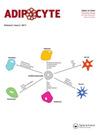胰岛素-AKT-UCP1信号传导的功能障碍抑制人和小鼠白色前脂肪细胞向棕色样脂肪细胞的转分化
IF 3.5
4区 生物学
Q2 ENDOCRINOLOGY & METABOLISM
引用次数: 3
摘要
胰岛素信号在白色前脂肪细胞褐变中的作用机制尚不清楚。在胰岛素信号完整或阻断的条件下,分别诱导人和小鼠原代皮下白色前脂肪细胞(分别为hsASCs和WT瘦型和肥胖型msASCs)转分化为米色脂肪细胞。在正常胰岛素信号传导、磷酸化蛋白激酶B(pAKT)、过氧化物酶体增殖物激活受体γ共激活因子-1α(PGC-1α)、含锌转录因子PRD1-BF1-RIZ1同源结构域蛋白16(PRDM16)、解偶联蛋白1(UCP1)、,过氧化物酶体增殖物激活受体γ(PPARγ)和CCAAT/增强子结合蛋白β(C/EBPβ)显著增加。相反,当胰岛素信号传导被不完全抑制时,产热和脂肪因子的表达显著降低,脂肪生成明显受损。然而,5’-单磷酸腺苷(AMP)激活蛋白激酶(AMPK)的磷酸化水平和1型SIRT1的表达水平增加。这些来自不同供体的白色前脂肪细胞在褐变过程中表现出相似的形态和分子水平的动态变化。目前的数据表明,胰岛素信号通过PI3K-AKT-UCP1信号通路在调节hsASCs和msASCs的褐变中起着重要作用。胰岛素-AMPK-SIRT1通路也参与了脂肪细胞的褐变,但其作用有限。本文章由计算机程序翻译,如有差异,请以英文原文为准。
Dysfunction of insulin-AKT-UCP1 signalling inhibits transdifferentiation of human and mouse white preadipocytes into brown-like adipocytes
ABSTRACT The mechanism of insulin signaling on browning of white preadipocytes remains unclear. Human and mouse primary subcutaneous white preadipocytes (hsASCs and WT lean and obese msASCs, respectively) were induced to transdifferentiate into beige adipocytes under conditions of intact or blocked insulin signaling, respectively. Level of phosphoinositide-3-kinase (PI3K) after induction of beige adipocytes under conditions of normal insulin signaling, phosphorylated protein kinase B (pAKT), peroxisome proliferator-activated receptor γ coactivator-1 alpha (PGC-1α), zinc-fifinger transcriptional factor PRD1-BF1-RIZ1 homologous domain-containing protein 16 (PRDM16), uncoupling protein 1 (UCP1), peroxisome proliferator-activated receptor gamma (PPARγ) and CCAAT/enhancer binding protein beta (C/EBPβ) were significantly increased. Conversely, when insulin signaling is incompletely inhibited, the expression of the thermogenic and adipogenic factors is significantly reduced, with obvious impairment of adipogenesis. However, phosphorylation level of adenosine 5’-monophosphate (AMP)-activated protein kinase (AMPK) and expression level of sirtuin type 1 (SIRT1) had increased. These white preadipocytes from different donors showed similar dynamic change in morphology and molecular levels during the browning. The present data indicate that insulin signaling plays a important role in regulation of browning of hsASCs and msASCs through PI3K-AKT-UCP1 signaling pathway. The insulin-AMPK-SIRT1 pathway was also involved in the adipocytes browning, while its effect is limited.
求助全文
通过发布文献求助,成功后即可免费获取论文全文。
去求助
来源期刊

Adipocyte
Medicine-Histology
CiteScore
6.50
自引率
3.00%
发文量
46
审稿时长
32 weeks
期刊介绍:
Adipocyte recognizes that the adipose tissue is the largest endocrine organ in the body, and explores the link between dysfunctional adipose tissue and the growing number of chronic diseases including diabetes, hypertension, cardiovascular disease and cancer. Historically, the primary function of the adipose tissue was limited to energy storage and thermoregulation. However, a plethora of research over the past 3 decades has recognized the dynamic role of the adipose tissue and its contribution to a variety of physiological processes including reproduction, angiogenesis, apoptosis, inflammation, blood pressure, coagulation, fibrinolysis, immunity and general metabolic homeostasis. The field of Adipose Tissue research has grown tremendously, and Adipocyte is the first international peer-reviewed journal of its kind providing a multi-disciplinary forum for research focusing exclusively on all aspects of adipose tissue physiology and pathophysiology. Adipocyte accepts high-profile submissions in basic, translational and clinical research.
 求助内容:
求助内容: 应助结果提醒方式:
应助结果提醒方式:


